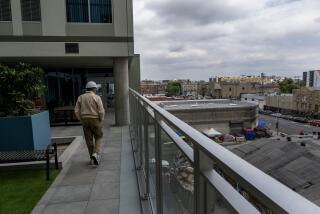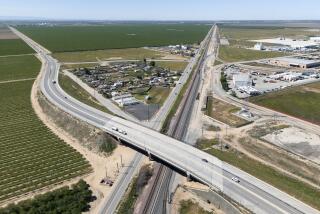From Perch 250 Feet Up, the Work Is Uplifting
From his seat in the control cage of a 250-foot crane near Warner Center in Woodland Hills, Chuck Laurutus of Moorpark has an odd perspective on the world.
“It’s like a big video game up there,” said the 48-year-old construction worker, in a pause between shifts at the site of what will soon be a 17-story Marriott Hotel on Topanga Canyon Boulevard. “There’s a lot of moving targets. You have to be alert.”
Laurutus has been operating so-called “tower cranes” for more than 24 years now, mostly as an employee of the Tutor-Saliba Corp., a Sylmar construction firm. He has spent the better part of his working career inside the mechanical equivalent of “a giant fishing pole” used to lift materials onto high-rise projects.
80-Ton Capacity
The French-built cranes, which can lift up to 80 tons, are becoming a common sight in the San Fernando Valley these days as more and more of the landscape is converted to office space.
Controlled by a set of “joy sticks” in the cage, the cranes are typically planted in concrete--in this case, 400 tons of concrete--with a tower extending several hundred feet into the air. A rotating cage sits on the top of the tower, under a long, thin “jib.” The jib is connected to a set of pulleys and cables fashioned with a hook or other device at the end that is used to pick up the cargo.
At the Marriott site, Laurutus has been a fixture in the cage since October, trading shifts with Dave Canine, a 54-year-old tower operator from San Diego. Each day, the two take turns loading the building with supplies, ranging from concrete floor sections to a bucket containing Laurutus’ lunch. They trade shifts regularly, each spotting potential problems while the other is perched at the top of the crane.
Pay and Benefits
As licensed crane operators, both Laurutus and Canine are members of the International Union of Operating Engineers, which lists on its roster 40 crane operators in Southern California. On the Marriott job, the two make $28 an hour with benefits, and as much as $1,600 a week with overtime.
Laurutus concedes that his fellow construction workers think of the two men as “maniacs” because they spend their days sitting in a metal box 250 feet in the air. But he insists that the work is a joy. Neither he nor Canine has ever been involved in an accident, Laurutus said, and neither gives much thought to other lines of work.
Still, Laurutus says he has had some strange encounters over the years. Working in Orange County, he once climbed to the top of a tower to find several hundred bees swarming around the cage, apparently looking for a hive with a view. On another job in Las Vegas, he was forced to stop work when several bird nests threatened to interfere with the workings of the cage.
Then there was the time Laurutus said he climbed to the top of a crane on Ventura Boulevard to find that the controls had been stolen.
“I don’t know what they (the thieves) were doing up there,” he said. “We never found the parts. It was weird.”
And at the Warner Center site, Laurutus recently poured three tons of “something that looked like concrete” on top of a brand new Cadillac as part of a stunt for the “Night Rider” television program. (The substance was later washed off.)
“I’m the villain,” he said, describing the plot of the episode. “They came over one day and had me chase the ‘Night Rider’ car around the site with the crane . . . . I’ve got it on tape at home. The car wins out in the end.”
Operator in Action
Laurutus said his “Night Rider” stunt had little in common with a regular day on the job, in which lifts are carefully controlled. Inside the crane’s air-conditioned cabin, the operator speaks constantly with ground loaders bearing walkie-talkies, while the operator watches the action through a glass-like bubble. Heavy lifts are abandoned during high winds or during heavy rains. When Canine is in the cage, Laurutus said, he inspects the crane, watching constantly for “loose bolts.”
If anything, those days are a strain, as the crane operator labors to get materials through the maze of construction.
But for Laurutus the work is fulfilling.
“You sit up there in that leather seat . . . and the view is just amazing,” he said. “It’s draining, but there’s solitude . . . . It makes you feel close to nature.”
More to Read
Sign up for Essential California
The most important California stories and recommendations in your inbox every morning.
You may occasionally receive promotional content from the Los Angeles Times.










